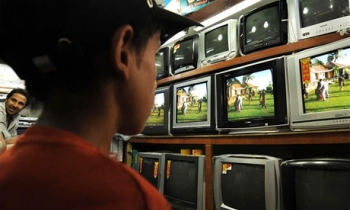NEW YORK (AdAge.com) -- Digital properties may be VC darlings, hot on Wall Street and coveted by advertisers. But try telling that to Dave and Jean Bretzlauf, 57-year-old accountants in a well-to-do-suburb of Denver. Dave has an iPod but no idea what a podcast is. Neither is familiar with RSS. And while they read the online versions of their local papers, they also subscribe to Rocky Mountain News and several magazines -- Reader's Digest and women's mags for Jean, financial and sports rags for Dave. They catch the morning news and never miss their favorite prime-time TV shows. And they've never logged on to watch online video.
"I love to check the internet for instant news and updates, but I still like reading the paper and magazines," Ms. Bretzlauf said. "I like being able to read one part of a magazine, put it down, then pick it back up again later. I don't think I'll ever change that."
Adults with steady incomes
While marketing prognosticators and technophiles rush into the future, raving about the next big content delivery system or ad model, the fact is most Americans -- notably adults with steady incomes -- still get their content the old-fashioned way.
Consider: According to Jupiter Research, 7% of American adults write blogs and 22% read them; about 8% listen to podcasts and 5% use RSS feeds. According to a separate study by WorkPlace Print Media, 88% of the at-work audience doesn't even know what RSS is. And recent data from word-of-mouth research group Keller Fay indicate 92% of brand conversations were taking place offline -- far more than the commonly assumed rate of 80%.
"We understand that while they're powerful new tools, the bulk of human interaction is still high-touch rather than high-tech," said Brad Fay, chief operating officer at Keller Fay.
Mobile technologies
The seeming unawareness of -- or apathy toward -- digital technologies extends to mobile as well. Only 1% of the country's 210 million mobile-phone subscribers said they choose service providers based on entertainment options, according to Jupiter Research, despite networks' best mobisode-creation efforts. Perhaps it shouldn't come as much of a shock that most Americans care more about price, coverage and service.
Teens and young adults echoed those sentiments in a recent Los Angeles Times/Bloomberg poll. About half were uninterested in viewing TV or movies on their computers, cellphones or hand-held devices.
Take Kate Mulvey, a 26-year-old professional living in Boston. The self-admitted news junkie favors CNN and PBS over a continuous RSS stream of headlines and uses an iPod -- but only for music. (She'd heard of podcasting, but not RSS.) During the day, she occasionally watches news videos on CNN.com or MSNBC.com but finds sitting through a 30-second spot for a two-minute news clip "annoying."
Perfers TV on TV
Or Barry Rosenberg, also 26, manager of publicity for A&E in New York. He surfs entertainment blogs ("they're well beyond fad phase," he said) and while he'll watch the occasional YouTube video, he prefers his TV on TV. He owns a video iPod, upgraded not for the video screen but for the additional memory. He thinks podcasts are "a buzzword that companies are using it to sell more virtual space." He considers reading the paper on the bus ride into Manhattan from New Jersey a "luxury."
Nicole Sawatzke, a 27-year-old TV producer from Minneapolis, summed it up: "I like knowing that [I] can have [content] anytime I want, but I don't feel the need to be attached."
Even among the younger 12-17 demographic, the numbers are somewhat surprising. While higher numbers of preteens and teens do flock to the web, according to a study by Frank N. Magid Associates, 66% claim they never watch video online and 41% never listen to or download free music online. When it comes to paid content, 84% have never paid to watch or download video and 71% never pay to listen to or download music. Sixty-nine percent never use social-networking sites, 71% have never posted a comment on a blog and 79% have never written their own blogs (though 15% do so frequently).
'A ton of ype'
"Obviously there's a ton of hype around these emerging channels, and clients are very frequently asking us about the viability of podcasts, how do you advertise in blogs," said Jason Heller, senior VP-managing director at Horizon Interactive. "There are some viable opportunities for certain clients, but the harsh reality is podcasting is incredibly nascent, and while RSS is a little further along, we see a very specific type of person using it."
Sometimes more telling than raw numbers -- how many people have downloaded a podcast or how many views a video got on YouTube -- is the attachment people feel to a particular medium. How long do they spend with it? Where does it rank in their daily media intakes?
Pew Research Center for the People & the Press surveyed 3,204 adults and found that their online interactions were broad -- but not deep. Those who logged on for news spent an average of 32 minutes online daily, significantly less than the time the same group recorded for other media sources -- 53 minutes watching TV news, 43 minutes listening to news on the radio and 40 minutes with a newspaper.
And Universal McCann recently polled what it considers "heavy internet users." More often than not, they said they'd miss TV more than the internet in the case of media withdrawal.
Reaching influencers
Still, nascent technologies appear to be a key to reaching influencers.
In Keller Fay's studies, for example, while 92% of brand conversations took place offline, nearly half involved some reference to media or marketing that people had seen or heard and were talking about. And the internet nearly tied TV as a reference source.
"The reality is it's a complicated process by which ideas are communicated to the market, and it's becoming more complex," Mr. Fay said. "All of these cutting-edge tools do have a significant and growing role to play, but they need to work in an integrated way with other tools."
It's important to remember the point of using these technologies isn't necessarily to reach a mass market, said Mohan Renganathan, VP-associate director of digital strategy at MediaVest Digital. "It's a very tactical element," he said, "and the strategy might be either to try out this new technology or speak to a very specific slice of your overall target segment."
Be-there-first incentive
And there's the be-there-first incentive -- the idea that marketers who get in early on digital trends find themselves poised to best exploit the technologies when they do explode --- two, three, four years down the road.
"It'll take a disproportionate time and effort in 2007 because of all the learning, but if you believe the [digital-media] growth curve continues, then you want to be in a position where you can move a decent chunk of money into it," said Jim Nail, chief marketing officer of Cymphony. Plus, "by that time there will be other companies -- probably your competitors -- who have spent the time to figure it out."









